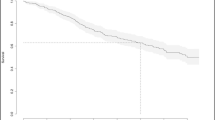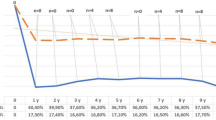Abstract
Background
Various types of adjustable gastric bands are used during LAGB, but there is insufficient data comparing different bands in the long term. We carried out a prospective randomized study to compare two different bands.
Methods
Between January 1, 2009 and January 31, 2010, 103 morbidly obese patients were randomized between SAGB and MiniMizer Extra adjustable gastric bands. The SAGB was used in 49 and MiniMizer Extra in 54 patients. Weight loss, comorbidities, long-term complications, and quality of life were evaluated after 5 years.
Results
Patient baseline characteristics were similar in the two groups. The mean patient age was 45.9 ± 11.7 years, and mean preoperative BMI was 47.5 ± 7.3 kg/m2. A total of 90 of 103 patients (87.3 %) completed the 5-year follow-up. The mean excess weight loss was 44.1 and 50.3 % in SAGB and MiniMizer groups, respectively (p = 0.14). A proportion of patients who reached a BMI < 35 kg/m2 was significantly larger in MiniMizer Extra group (52.9 vs 25.5 %; p = 0.01). Complications developed in 15 patients (14.5 %) and consisted of 5 band erosions, 4 port-related complications, 3 band slippages, and 3 band intolerances. All five band erosions developed in MiniMizer Extra group, but the difference was not significant (p = 0.058). No difference was found regarding postoperative complications, resolution of comorbidities, and quality of life between compared groups.
Conclusions
SAGB and MiniMizer Extra bands demonstrated similar long-term results regarding the weight loss, resolution of comorbidities, morbidity, and quality of life.


Similar content being viewed by others
References
Colquitt JL, Picot J, Loveman E, et al. Surgery for obesity. Cochrane Database Syst Rev. 2009;2:CD003641.
Suter M, Giusti V, Worreth M, et al. Laparoscopic gastric banding: a prospective, randomized study comparing the Lapband and the SAGB: early results. Ann Surg. 2005;241(1):55–62.
Gero D, Dayer-Jankechova A, Worreth M, et al. Laparoscopic gastric banding outcomes do not depend on device or technique. Long-term results of a prospective randomized study comparing the Lapband® and the SAGB®. Obes Surg. 2014;24(1):114–22.
Szewczyk T, Modzelewski B. Perioperative comparison of the MiniMizer extra band with the other laparoscopic gastric bands. Obes Surg. 2006;16(5):646–50.
Abalikšta T, Brimas G, Strupas K. Laparoscopic adjustable gastric banding. A prospective randomized study comparing the Swedish Adjustable Gastric Band and the MiniMizer Extra: one-year results. Wideochirurgia i inne Tech małoinwazyjne = Videosurgery other miniinvasive Tech / Kwart Pod patronatem Sekc Wideochirurgii TChP oraz Sekc Chir Bariatrycznej TChP. 2011;6(4):207–16.
Oria HE, Moorehead MK. Bariatric analysis and reporting outcome system (BAROS). Obes Surg. 1998;8(5):487–99.
Report of the expert committee on the diagnosis and classification of diabetes mellitus. Diabetes Care. 20031;26(Supplement 1):S5–20.
McKenney JM. Update on the National Cholesterol Education Program Adult Treatment Panel III guidelines: getting to goal. Pharmacotherapy. 2003;23(9 Pt 2):26S–33S.
Moorehead MK, Ardelt-Gattinger E, Lechner H, et al. The validation of the Moorehead-Ardelt Quality of Life Questionnaire II. Obes Surg. 2003;13(5):684–92.
Steffen R, Biertho L, Ricklin T, et al. Laparoscopic Swedish adjustable gastric banding: a five-year prospective study. Obes Surg. 2003;13(3):404–11.
Singhal R, Kitchen M, Ndirika S, et al. The “Birmingham stitch”--avoiding slippage in laparoscopic gastric banding. Obes Surg. 2008;18(4):359–63.
Egberts K, Brown WA, O’Brien PE. Systematic review of erosion after laparoscopic adjustable gastric banding. Obes Surg. 2011;21(8):1272–9.
Abu-Abeid S, Bar Zohar D, Sagie B, et al. Treatment of intra-gastric band migration following laparoscopic banding: safety and feasibility of simultaneous laparoscopic band removal and replacement. Obes Surg. 2005;15(6):849–52.
O’Brien P, McPhail T, Chaston T, et al. Systematic review of medium-term weight loss after bariatric operations. Obes Surg. 2006;16(8):1032–40.
Singhal R, Bryant C, Kitchen M, et al. Band slippage and erosion after laparoscopic gastric banding: a meta-analysis. Surg Endosc. 2010;24(12):2980–6.
Choi SH, Kasama K. Bariatric and metabolic surgery. Heidelberg New York Dordrecht London: Springer; 2014.
Meir E, Van Baden M. Adjustable silicone gastric banding and band erosion: personal experience and hypotheses. Obes Surg. 1999;9(2):191–3.
Ren CJ, Weiner M, Allen JW. Favorable early results of gastric banding for morbid obesity: the American experience. Surg Endosc. 2004;18(3):543–6.
Lattuada E, Zappa MA, Mozzi E, et al. Injection port and connecting tube complications after laparoscopic adjustable gastric banding. Obes Surg. 2010;20(4):410–4.
Keidar A, Carmon E, Szold A, et al. Port complications following laparoscopic adjustable gastric banding for morbid obesity. Obes Surg. 2005;15(3):361–5.
Author information
Authors and Affiliations
Corresponding author
Ethics declarations
Conflict of Interest
The authors declare that they have no conflict of interest.
Ethical Approval
All procedures performed in study were in accordance with the ethical standards of the institutional and national research committee and with the 1964 Helsinki declaration and its later amendments.
Informed Consent
Informed consent was obtained from all individual participants included in the study.
Financial Support
This study received no financial support
Rights and permissions
About this article
Cite this article
Juodeikis, Ž., Abalikšta, T., Brimienė, V. et al. Laparoscopic Adjustable Gastric Banding: a Prospective Randomized Clinical Trial Comparing 5-Year Results of two Different Bands in 103 Patients. OBES SURG 27, 1024–1030 (2017). https://doi.org/10.1007/s11695-016-2416-5
Published:
Issue Date:
DOI: https://doi.org/10.1007/s11695-016-2416-5




